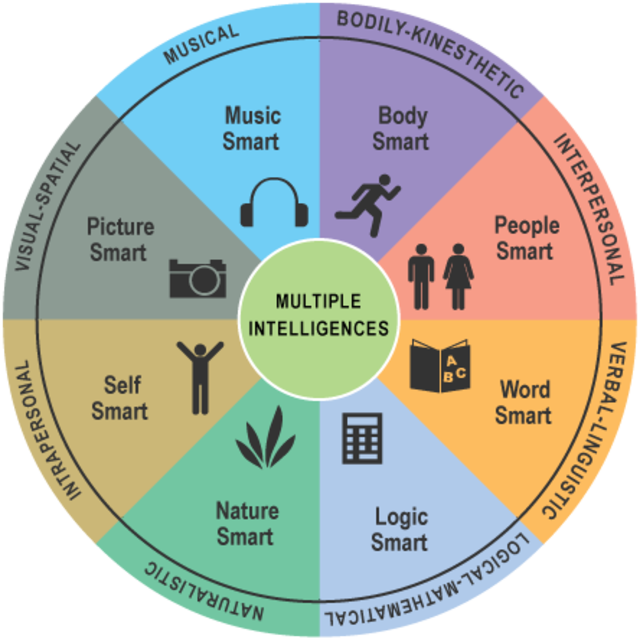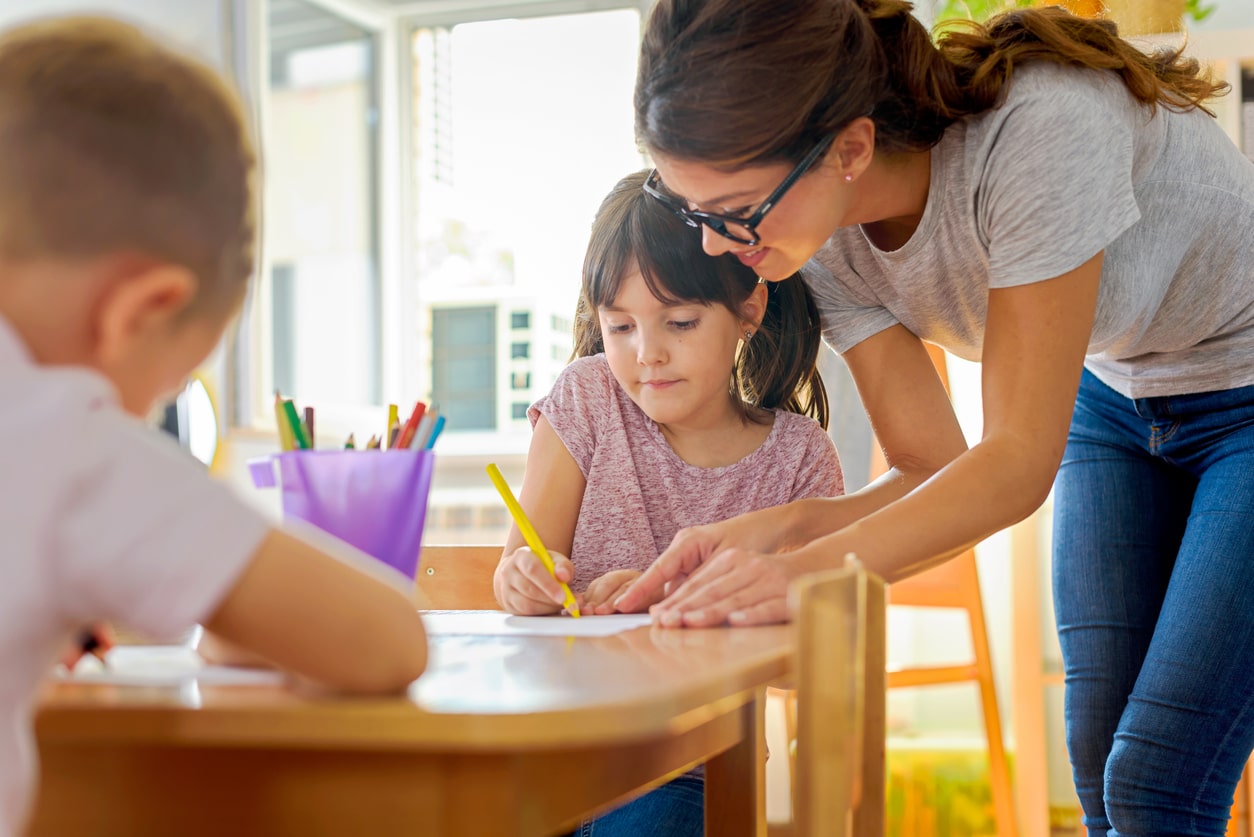Download for free!
Multiple Intelligences Activities
Understanding the different ways individuals process and interpret information can lead to more effective teaching and learning. This guide explores the concept of multiple intelligences, a theory proposed by Howard Gardner, that identifies eight distinctive learning styles. For each type of intelligence, we provide a variety of multiple intelligence activities and teaching tips that can be used in the classroom to engage students and enhance their learning experience.
What are the Multiple Intelligences?
The theory of multiple intelligences dates back to 1983 in Howard Gardner’s book Frames of Mind. The theory suggests that there are eight different ways that people learn and process information, each it’s own “intelligence.” These intelligences include:
- Logical-mathematical (number/ reasoning smart)
- Visual-spatial (picture smart)
- Naturalist (nature smart)
- Bodily-kinesthetic (body smart)
- Musical-rhythmic (music smart)
- Interpersonal (people smart)
- Intrapersonal (self smart)
- Verbal-linguistic (word smart)
Each individual may possess a unique blend of these intelligences, and understanding them can help tailor education and learning to an individual's strengths.

Why use multiple intelligence activities in the classroom?
Using multiple intelligence activities in the classroom allows educators to cater to the varied ways in which different students learn and process information.
By engaging multiple intelligences, teachers can create a more inclusive and effective learning environment that plays to each student's strengths. This approach can increase student engagement, improve retention of information, and foster a deeper understanding of the material. Ultimately, it can lead to a more personalized and effective learning experience for each student.
Multiple Intelligence activities for school

Logical-Mathematical Intelligence Type
Those with the logical-mathematical intelligence type enjoy working with numbers and doing experiments.
Teaching tip:
- Use "science thinking": Ask students to identify scientific principles in areas other than science.
Fun activities for grades 4-6:
- Find three random things (for example, a blade of grass, the word "long," and the process "jumping") and ask your students to invent an object that uses all three.
Fun activities for grades 6-8:
- Ask students to reinvent or improve upon the designs of everyday objects.
Visual-Spatial Intelligence Type
Those with visual-spatial intelligence are typically very good at visualizing and mentally manipulating objects. They have a strong visual memory and are often artistically inclined.
Teaching tips:
- Encourage students to use drawings or diagrams to help them understand concepts.
- Use colors as visual cues: Use a variety of colors of chalk and markers when writing in front of the class. Students can use different colored markers to "color code" materials they are studying.
Fun activities for grades 4-6:
- Give students a complex image and ask them to draw it from memory.
- Draw an unusual shape and have each student include it in a drawing of his or her own.
Fun activities for grades 6-8:
- Have students create a comic strip to explain a concept.
- Play drawing games such as Pictionary or Win, Lose or Draw. Have students make rapid drawings to capture key points being discussed in a class lesson.
Naturalist Intelligence Type
Those with Naturalist Intelligence have a sensitivity to and appreciation for nature. They are often interested in nurturing, exploring the environment and learning about other species. These individuals are said to be highly aware of even subtle changes to their environment.
Teaching tips:
- Incorporate outdoor activities or nature-based examples in your lessons.
- Noticing patterns: Encourage students to form their own systems for sorting and categorizing information.
Fun activities for grades 4-6:
- Nature scavenger hunts.
- Show pictures of various animals or plants and ask students to figure out what they have in common.
Fun activities for grades 6-8:
- Given certain basic guiding principles, ask students to describe an animal, ecosystem, or other natural entity. To stimulate creativity, the entity need not exist at present, but should be theoretically imaginable.
- Conducting simple experiments with plants or natural elements.
- Nature photography or drawing.
Bodily-Kinesthetic Intelligence Type
Those with bodily-kinesthetic intelligence are typically very active and coordinated. They have a strong sense of body awareness and like to move around. They may be good at sports, dance, acting, and other physical activities. They learn best by doing and participating in activities.
Teaching tip:
- Classroom theater: Students can act out the material to be learned through role-playing.
Fun activities for grades 4-6:
- Ask students what they like to eat for lunch – and have them act out the answers in a game of charades.
ure scavenger hunts.
- Plant or animal observation and reporting.
Fun activities for grades 6-8:
- Use the human body as a "map" for learning new information in different subjects. In geography, for example, the body might represent Europe. If the head is Scandanavia, then where is Italy?
Musical-Rhythmic Intelligence Type
Those with musical-rhythmic intelligence have a strong appreciation for music and are often good at musical composition and performance. They have a good sense of rhythm and pitch. They may learn best by using rhythm or music, and they are often able to use music to help them remember things.
Teaching tip:
- Create discographies: Supplement bibliographies with lists of recorded music relating to class material. Also, as part of a homework assignment, have students select music that best demonstrates lesson themes.
Fun activities for grades 4-6:
- Play unusual or difficult-to-recognize sounds and ask students to imagine what they might be.
Fun activities for grades 6-8:
- Some students can more easily memorize information if they listen to a teacher's lesson against a musical background. Baroque and classical music can be particularly effective.
Interpersonal Intelligence Type
Those with interpersonal intelligence are often extroverts and are characterized by their sensitivity to others' moods, feelings, temperaments and motivations, and their ability to cooperate in order to work as part of a group. They communicate effectively and empathize easily with others, and may be either leaders or followers. They typically learn best by working with others and often enjoy discussion and debate.
Teaching tip:
- Peer sharing: Set up a class "buddy system" so students can share and develop ideas with the same person over a period of time.
Fun activities for grades 4-6:
- Make learning a fun and cooperative effort with class-made board games. Using file folders, markers, dice, and small game pieces, the information to be learned can be placed on squares of a winding road or on separate cards.
Fun activities for grades 6-8:
- Ask students to think of the results of unlikely events. For example, "What if all of us could feel each other's feelings?"
Intrapersonal Personality Type
Those with intrapersonal intelligence are often introverts and prefer to work alone. They are self-aware and capable of understanding their own emotions, goals, and motivations. They often have an affinity for thought-based pursuits such as philosophy. They learn best when allowed to concentrate on the subject by themselves. There's often a high level of perfectionism associated with this intelligence.
Teaching tip:
- Personal connections: To make learning more directly relevant, make connections between class material and students' lives. To spark discussion, ask: "How many of you have ever…" Or "Can you tell about a time when you…"
Fun activities for grades 4-6:
- Start individual or class scrapbooks for remembering special events.
Fun activities for grades 6-8:
- Provide opportunities for setting goals and charting progress toward these goals. Goals may be short-term ("List three things you'd like to learn today") or long-term ("What do you want to be doing ten years from now?").
Verbal-Linguistic Personality Type
People with verbal-linguistic intelligence are good with words, both when it comes to writing and speaking. They have a strong affinity for language, enjoying activities such as reading, writing, and debate. They can aptly express themselves and are usually good at learning other languages. They tend to think in words and like hearing and seeing words. They may love to tell stories and can remember information after reading or hearing it once.
Teaching tip:
- Tape recording: To help students clarify their thinking, have them use a tape recorder to talk out loud about a problem or project. Recordings can also be used as a writing tool.
Fun activities for grades 4-6:
- Have students think of as many things as possible that share a certain property, such as things that are round (sun, balloons, a squashed soda can), and encourage creative answers.
Fun activities for grades 6-8:
- Invent nicknames for well-known people that capture features that make the individuals unique.






